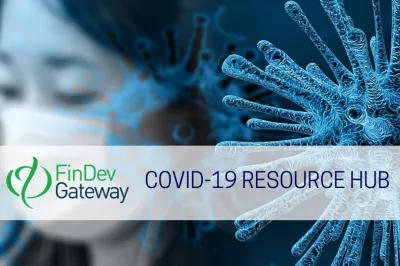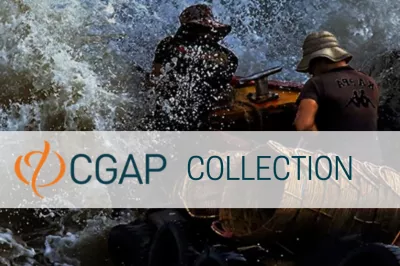FinDev COVID-19 Update | 28 Jan - 10 Feb 2021

FinDev Gateway has created this COVID-19 Update with the latest and most relevant knowledge resources for financial inclusion. Sign up to receive this update to your inbox.
If you have content to share in our COVID-19 update, please submit here or contact us directly.
Do you find the FinDev Update useful? Take a moment to let us know >>
Global Update
- A new crisis response roadmap by CGAP provides practical guidance to MFIs on how to navigate crises, drawing from lessons learned from past crises that have affected MFIs in various parts of the world.
- AFI says financial regulators need to look more closely at emerging risks associated with climate change. Financial regulation plays a critical role in disaster risk management, from policies that help financial institutions plan for disasters to measures that support post-disaster economic recovery.
- MFI recovery from the coronavirus pandemic remains fragile. Although the latest Symbiotics data show only a slight increase in portfolio at risk (PAR) 30 in September and October 2020, this may change as moratoria are lifted. In Africa, expiration of moratoria has led to an increase of PAR.
Asia
- Concerns are rising in India about consumer protection and the lack of regulations for fintech or app loans, which have grown in popularity during the pandemic, due to reports of high interest rates, data privacy violations, unethical debt collection practices and most alarmingly, incidents of suicide among customers unable to repay.
- The countries of Southeast Asia are working to connect their payment systems as the pandemic has accelerated the use of digital payments in the region. Singapore and Thailand have made plans to link up their national payment systems by mid-2021, and Thailand has also set up QR payment linkages with Cambodia, Japan and Laos.
- The payments platform i2c has partnered with Pakistani fintech TAG to launch a super app which will provide instant payments capability for Pakistan’s unbanked adult population.
- In Thailand, digital savings products have gained traction due to the lockdown and financial relief packages, with several banks and fintechs offering interest-bearing e-savings accounts. While deposit account openings via mobile banking apps doubled during the lockdown, digital deposits still remain a small portion of overall deposits.
Africa
Some articles and knowledge resources referenced in this section are in French.
- At least 80 percent of MFIs in Sub-Saharan Africa surveyed in December 2020 by Grameen Crédit Agricole Foundation, ADA and Inpulse said that over 70 percent of their clients have returned to work after lockdowns. Also, 74 percent of surveyed MFIs reported an increase in portfolio at risk.
- According to the Central Bank of West African States’ latest report on the microfinance sector, the portfolio at risk in the West African Monetary Union region rose to 9.1 percent compared with 7.6 percent at the end of September 2019. This sharp increase is linked to a rise in overdue loans related to the COVID-19 crisis.
- Remittances to The Gambia increased by 78 percent in 2020 from the previous year, whereas they fell by 14 percent in Uganda. The World Bank had predicted a 9 percent drop in Sub Saharan Africa’s remittances in 2020.
- The telco giant Airtel Africa reported a 34 percent growth in its mobile money revenue between March and December 2020. Airtel Africa has also partnered with remittances providers like MoneyGram, Mukuru and WorldRemit to facilitate remittance transfers. As mentioned in previous updates, the crisis has been a catalyst for telco companies in Africa.
For more on Africa, check out the latest Portail FinDev Biweekly Update in French.
Latin America and the Caribbean
Most articles and knowledge resources referenced in this section are in Spanish.
- In Peru, all citizens will have a digital savings account with Banco de la Nación, the country’s national bank, based on a new law that enables the government to open accounts using National Identity Document (DNI) numbers. The accounts will be used for government transfers and refunds, including those related to COVID-19.
- The female participation rate in the labor force in Latin America and the Caribbean fell by 6 percentage points in 2020, erasing at least 10 years of gender progress, according to a new report by ECLAC. More than 55 percent of women in the region work in the hardest hit sectors, including domestic services and tourism.
- Mexican migrants in the United States will be able to open bank accounts remotely with the state-owned bank Banco del Bienestar, while their families in Mexico will be able to open their own accounts and cash out in pesos. This new policy aims to bring both migrants and remittance recipients into the banking system and facilitate remittance transfers, which are a lifeline for many low-income households in Mexico.
- The number of people without a bank account in Brazil dropped by 73 percent, driven by government transfers related to COVID-19. The country’s instant payment system, PIX, launched last November, will continue to bring the number of unbanked people down. There are currently 134 million user accounts, with a daily transaction volume between $930 million and $1.12 billion.
- In Argentina, despite the digital wave propelled by the COVID-19 pandemic, there is still a strong preference for cash. Mercado Libre, the biggest e-commerce platform in the region will offer cash withdrawal services in stores through its digital wallet Mercado Pago and QR code, a service until now reserved for debit cards.
For more on LAC, check out the latest Portal FinDev Biweekly Update in Spanish.
Arab World
- Facing a political deadlock, financial crisis, and the pandemic, Lebanon’s economy, which previously had the second highest account ownership rate among the Arab world’s developing countries, has become increasingly cash-based over the past year, with digital payments less and less accepted. The microfinance sector has shrunk over this time as well, primarily due to the deterioration of borrowers’ livelihoods, according to a survey conducted by CGAP and the Lebanese Microfinance Association.
- Morocco’s insurance industry has suffered during the COVID-19 pandemic and regulatory measures to date have focused on temporary short-term fixes. Now, insurance companies are asking the regulator to look into measures to contain the impact of pandemics in the medium and long term.
- Household income in Yemen fell on average by 12.5 percent in 2020 from the previous year, driven by lower remittances and lower incomes due to the contraction of the agriculture and services sectors during the pandemic.
- Egyptian expatriates sent $27.1 billion back home from January to November of 2020, 12 percent more than during the same period in 2019.
- A guarantee from the European Bank for Reconstruction and Development will allow Attijari Bank of Tunisia to extend a $7.4 million loan to MFI Enda Tamweel for on-lending to local MSMEs in need of financial support due to the coronavirus pandemic.
- The European Investment Bank has provided $3.3 million to the Microfund for Women to help finance female microentrepreneurs in Jordan during and after the COVID-19 pandemic.
For more on the Arab world and resources in Arabic, check out the latest FinDev Update in Arabic.
COVID-19 Resources

COVID-19 Resource Hub
A collective space for the financial inclusion community to share experiences and lessons learned from the pandemic
FinDev Coronavirus Data Tracker
Data relevant for financial inclusion - find out who is tracking what

Blogs & Opinion
If you have a blog idea and would like to write for the FinDev Blog, please review our guidelines. We do not cross-post blogs that have been published elsewhere, but if you wish to share an existing blog post in our next FinDev COVID-19 Update, you can send it to us using our contact form.
Women’s Financial Inclusion
Five Exciting Trends in Gender Inclusive Finance in 2021
06 Feb 2021 | Majidah Hashim | Alliance for Financial Inclusion (AFI)
Building Resilience and Savings for Women Customers Post COVID-19
04 Feb 2021 | Women’s World Banking
MFIs
Tackling NPLs: The Role of Effective Insolvency Regimes
02 Feb 2021 | Mahesh Uttamchandani, Antonia Menezes & Sergio Muro | World Bank
Management by Objectives in Times of Crisis
31 Jan 2021 | Elise Juguet | Boulder Institute of Microfinance
Fintech
Have the Stars Finally Aligned for Middle Eastern Fintech?
10 Feb 2021 | Mondato
Fintech in the New Normal: How Four Startups Are Innovating During COVID-19
05 Feb 2021 | Nosa Omusi | BFA Global
Digital Finance in India
India: Rural Women Go Digital to Manage the Pandemic’s Disruptions
10 Feb 2021 | Mehnaz Safavian, Tushar Arora & Karthik Laxman | World Bank
Digital ID in the Time of COVID-19 in India
07 Feb 2021 | Mitul Thapliyal, Venkat Goli, Saborni Poddar & Sneha Sampath | MicroSave Consulting (MSC)
Addressing Three Key Issues of BC Agents in India for COVID-like Challenges
28 Jan 2021 | Sunil Bhat, Sharad Bangari, Anil Gupta & Pritam Patro | MicroSave Consulting (MSC)
Remittances
Pandemic-Proof? Revisiting Remittance Rails
03 Feb 2021 | Mondato
Remittances Are Key To The Recovery In Developing Countries
27 Jan 2021 | Hikmet Ersek | World Economic Forum
Socioeconomic Impact and Social Protection
COVID-19-Induced Crises of Hunger and Poverty Require Bold, Effective International Response
09 Feb 2021 | Innovations for Poverty Action (IPA)
Social Protection in Argentina, Brazil, Colombia, and Mexico During the Pandemic
04 Feb 2021 | Merike Blofield, Nora Lustig & Mart Trasberg | Center for Global Development (CGD)
Understanding the Impacts of COVID-19 on Rural Households in Kenya
03 Feb 2021 | Rural & Agricultural Finance Learning Lab
Four Revealing Observations From The New State Of Economic Inclusion Report 2021
26 Jan 2021 | Michal Rutkowski, Rakesh Rajani, Shameran Abed & Birgit Pickel | World Bank
Recent Publications
Do you have a publication to add to this list? Share your work on FinDev Gateway.
MFIs
Microfinance Institutions Maintain Rebound, but Solvency Questions Loom
CGAP, Symbiotics | Feb 2021
Crisis Roadmap for Microfinance Institutions: COVID-19 and Beyond
CGAP | Feb 2021
Financial Sector Regulation
Disaster Resilience Through Financial Inclusion
Alliance for Financial Inclusion (AFI) | Feb 2021
How Insolvency and Creditor-Debtor Regimes Can Help Address Nonperforming Loans
World Bank | Feb 2021
Socioeconomic Impact and Social Protection
Social Protection During the Pandemic: Argentina, Brazil, Colombia, and Mexico
Center for Global Development | Feb 2021
Impact of COVID-19 on the Yemeni Economy
International Food Policy Research Institute (IFPRI) | Feb 2021
Impact of COVID-19 Pandemic on Micro, Small & Medium Enterprises (MSMEs): Bangladesh Report
MicroSave Consulting (MSC) | Jan 2021
Digital Finance
Identification for Development (ID4D) 2020 Annual Report
World Bank | Feb 2021
Women’s Financial Inclusion
Her Resilience in the Face of COVID-19
Women's World Banking | Jan 2021
Remittances
The Remittance Effect: A Lifeline for Developing Economies Through the Pandemic and Into Recovery
Oxford Economics | Jan 2021
View All Publications Related to COVID-19 >
Upcoming Webinars
Credit Operations in Crisis Times: New and Not So Normal | EaSI Technical Assistance Webinar
18 Feb 2021 | European Microfinance Network
Reaching Financial Equality - A Call to Action
08 Mar 2021 | Women's World Banking, World Bank, Better Than Cash Alliance, United Nations Capital Development Fund (UNCDF)
View All Upcoming Events Related to COVID-19 >
News
IFC Initiative to Help Financial Institutions Support Small Businesses Disrupted by Pandemic
| International Finance Corporation (IFC) | Global
Super Apps Rising: Mobile Drives Digital Payments Uptick in Pakistan
| Pymnts.com | Pakistan
View All News Related to COVID-19 >
Quick Links:
FinDev Guide
About this guide
Published
Topics
Contributed by a global financial inclusion community member. Share your lessons learned
Write for usLeave a Comment
Comments on this page are moderated by FinDev Editors. We welcome comments that offer remarks and insights that are relevant to the post. Learn More


